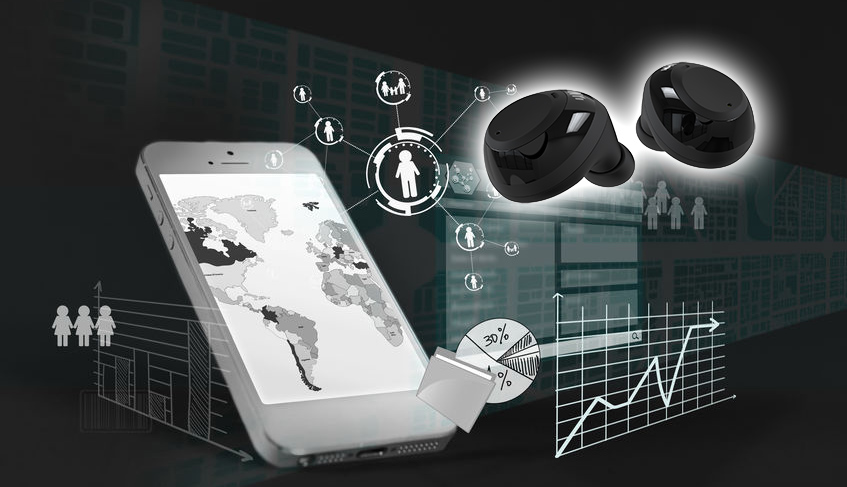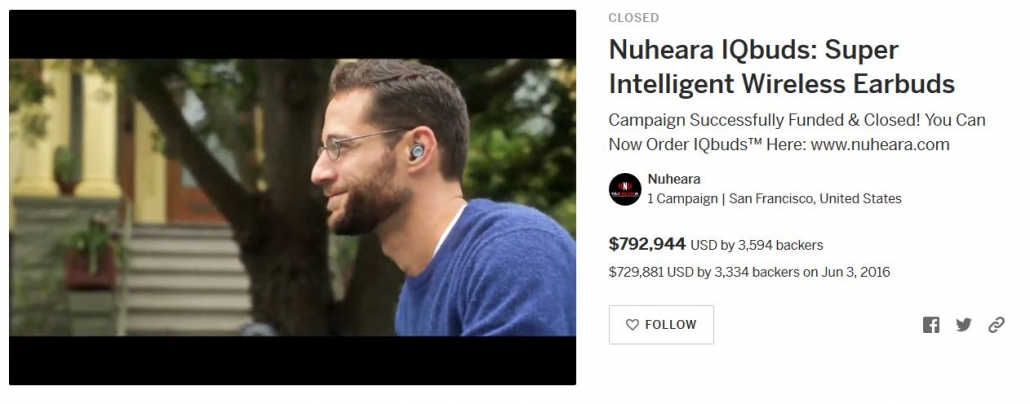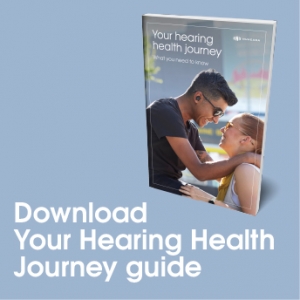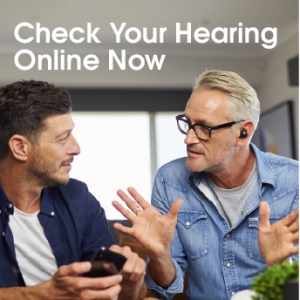
The 1st two decades of the 21st century have witnessed remarkable advances in technology. These advances include breakthroughs in automation and robotics to artificial intelligence and more. From a consumer technology perspective, one of the most noticeable areas of advance has been in the “wearables” space.
The early wearables market was dominated by fitness tracking applications such as the Fitbit and other wrist-worn devices. However, today there is an abundance of smart watches, glasses, jewelry, and more available to consumers. However, perhaps the biggest area of recent and future growth is with in-ear devices, known as “hearables”.
What is a Hearable?
Thanks to the development of smaller and more efficient batteries, advances in digital signal processing (DSP) technology, improving Bluetooth range, and more, a convergence has taken place between wireless earbuds and traditional hearing aid devices. This new range of smart wireless earbuds with hearing enhancement capabilities has come to be known as hearables.
Recently Scotland’s National Health Service (NHS) defined the burgeoning category of hearables as follows: “Devices that are primarily intended to allow streaming of media to the device but that also offer a hearing enhancing function not dissimilar to a hearing aid.”
[av_video src=’https://www.youtube.com/watch?v=IHNVKUxpZKw’ mobile_image=” attachment=” attachment_size=” format=’16-9′ width=’16’ height=’9′ conditional_play=” id=” custom_class=” av_uid=’av-8pc7a’]
Original credit for the term “Hearables” goes to technology analyst and evangelist Nick Hunn, who coined the moniker in his 2014 blog post titled, “Hearables – the new Wearables.” Referring to the ear as “the new wrist” for wearable technology, Hunn was among the first to note the massive potential of in-ear devices to seamlessly interact with smartphones and other technology.
Why the Ear is Uniquely Suited for Wearable Technology
In today’s global world of mass media and digital everything, the consumer attention span has increasing value. Mike Elgan of ComputerWorld recently wrote the following regarding consumer time and attention:
“Your work demands them. Advertisers need them. Broadcast media crave them. Social networks want them. Marketers, charity panhandlers, evangelists, celebrities, smartphone apps, political campaigns and others are all clamoring for you to focus on them and ignore the rest.”
But what makes the ear so uniquely well positioned to be the conduit between a consumer and his or her smartphone and other personal electronic devices? As Poppy Crum, a chief scientist at Dolby Laboratories and an adjunct professor at Stanford University recent wrote for IEEE Spectrum:
“The ear is like a biological equivalent of a USB port. It is unparalleled not only as a point for “writing” to the brain, as happens when our earbuds transmit the sounds of our favorite music, but also for “reading” from the brain. Soon, wearable devices that tuck into our ears will monitor our biological signals to reveal when we are emotionally stressed and when our brains are being overtaxed. When we are struggling to hear or understand, these devices will proactively help us focus on the sounds we want to hear.”
The Early Days of Hearable Technology
Around the time that Nick Hunn published his post that introduced the world to the term, Hearables, a number of companies were in the early stages of developing what would become the pioneering products in the hearables space. Among them were:
- Bragi, a German company based in Munich
- Doppler Labs, an American company headquartered in San Francisco
- Nuheara, jointly run out of Perth and Australia in its early days.
Bragi raised its initial funds through successful KickStarter campaign. That campaign was quick;y followed by another $22 million investment from a group of American, European and Asian investors in November of 2015. Shortly therafter, they released The Dash in early 2016. Though plagued by lengthy delays in meeting production timelines and a number of early bugs and connectivity issues, The Dash was nonetheless an early standout and important step in the evolution of hearable devices.
Doppler Labs was an early leader in the hearables industry, raising over $50m following a 2016 Series B financing round. Their flagship product, Here One, launched in February 2017, was also plagued by manufacturing delays and short battery life. Though it ultimately never came to fruition, the Here One was a notable step forward towards founder Noah Kraft’s vision of a mass-produced “in-ear computer.”
Nuheara raised early funding via a 2016 IndieGoGo crowdfunding campaign and a reverse listing on the Australian Stock Exchange (ASX). The 1st of the award-winning IQbuds went into production and shipped to early backers in early 2017. The 2nd-generation IQbuds BOOST debuted in late February of 2018, followed by the IQstream TV add-on device in June of 2019.

IQbuds successful crowdfunding campaign from mid-2016
The State of Hearables Today
In October of 2017, Doppler Labs ceased operations following lackluster sales for the Here One and an inability to secure the necessary financing to continue sufficient future operations. In April of 2019, Bragi announced they would be selling off their hardware business, ceasing manufacturing or earbuds, and focusing strictly on software and artificial intelligence technologies. The downfall of two once-promising startups serves as a reminder of the difficulty in launching a hardware-based consumer electronics company.
Nonetheless, not all is doom and gloom in the current world of hearables. Nuheara continues to steadily expand its reach, with direct-to-consumer reach and retail partnerships in Australia, Europe, North America, and Asia. Furthermore, growing acceptance and adoption of hearable devices is evident through developments such as the following:
- Formal recognition of the hearables category by the NHS Scotland
- The eligibility of reimbursement for purchase of devices like IQbuds and IQbuds BOOST through Australian government programs such as the HSP (Hearing Services Program) and NDIS (National Disability Insurance Scheme)
- The passage of the Over-the-Counter Hearing Aid Act and expected issuance of FDA regulations in 2020.
- The continued growth in consumer adoption of less-advanced in-ear wireless earbuds normalizing the usage of truly wireless, in-ear devices.
The Future of Hearables
2020 is poised to a massive year for hearables. With the mass media recognizing the growing convergence between wireless earbuds and hearing aids, the implementation of guidelines for the 2017 Over-the-Counter Hearing Aid Act will be a major event. A massive percentage of individuals suffering from mild-to-moderate hearing loss currently decline to seek treatment. The hope is that hearables will open up more accessible and affordable hearing options.
As voice recognition technology becomes better integrated with an array of technologies from search engines to smart home products and more, hearables will play an instrumental role. As this technology matures, many are speculating that earbuds will become a platform for increasingly advanced software and services. Consequently, these services would be available via a subscription model. For tech companies, the ear holds far greater potential than just phone calls, music, and podcasts. Technologists envision a future where AI-powered virtual assistants interact with hearables users through their ear, providing information on-demand.
Quite simply, the sudden ubiquity of in-ear devices thanks to the likes of Apple, paired with the engineering ingenuity and innovation of hearables pioneers such as Nuheara and others, has set the stage. In the coming years, look for in-ear devices to revolutionize our everyday lives. Going further, they may even shape the future of consumer technology as a whole.


